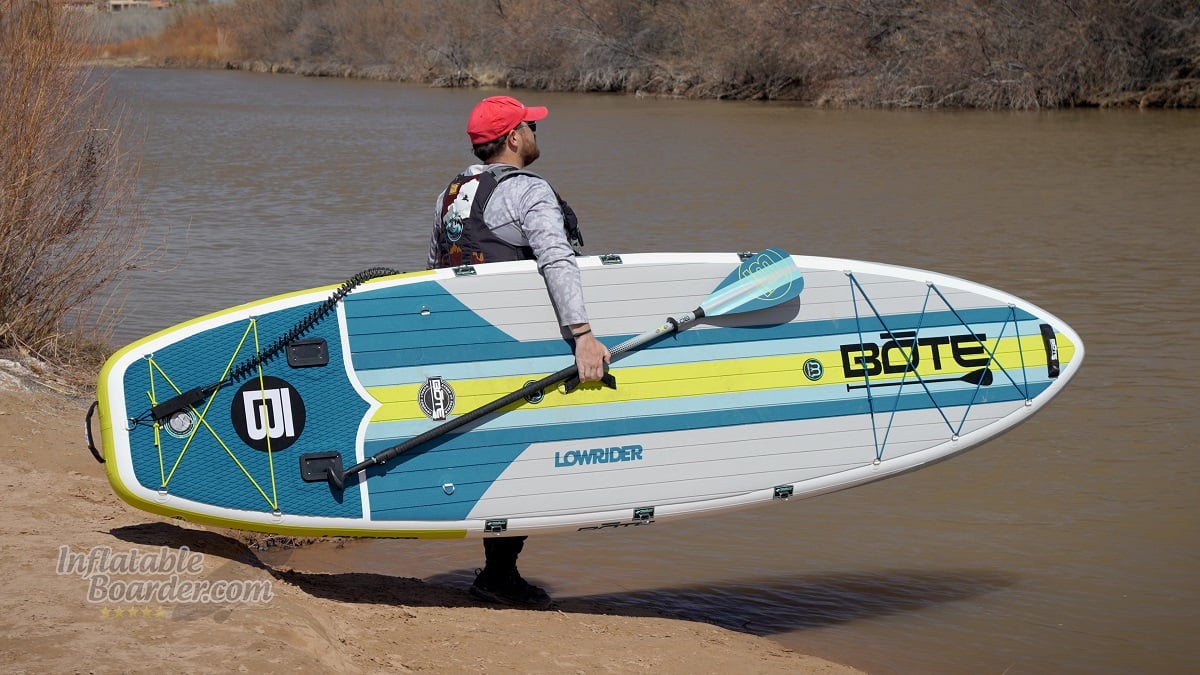
The Bote LowRider 11’6 is a tandem-capable inflatable paddle board and kayak hybrid in one convenient kit.
Bote LowRider 11’6 Tandem iSUP+Kayak Review – Overview
The Bote LowRider 11’6 is a dual-purpose, dual-paddler inflatable stand up paddle board that includes a full kit for two stand up paddlers, you can inflate the seats and change the paddles for tandem kayaking, or mix-and-match with this versatile system.
The extra wide size of the board gives it great stability for tandem paddling, on-board workouts and yoga, or SUP/Kayak fishing.
— Bote LowRider 11’6 Tandem iSUP+Kayak Review Summary and Ratings —
Bote LowRider 11’6 Tandem iSUP+Kayak
-
Construction & Durability
-
Features and Versatility
-
Stability
-
Speed
-
Maneuverability
-
Tracking
Overall Score
The Bote LowRider 11’6 is a tandem inflatable paddle board and kayak system in a single convenient kit.
Pros
- Large size is fully capable of supporting two adults for SUP or kayak paddling
- Full length deck pad allows you to use the entire length of the board comfortably and securely
- Two Magnepod accessory mounts included for tandem use
- Inflatable kayak seats and convertible paddles included for both paddlers
- Excellent tracking performance for such a wide board
- SUP fishing ready with the included AeroRack receivers
Cons
- Lightweight AeroUltra construction is quite flexible, especially compared to Bote’s dual layer AeroBote construction
- Seating configurations for two paddlers can feel tight for paddlers over 6’ tall
- Very heavy full kit weight
Bote LowRider 11’6 Tandem iSUP+Kayak Review – Construction and Durability
The Bote LowRider 11’6 Tandem SUP and kayak is made with Bote’s lightweight AeroUltra construction to keep the board-only weight under 25 pounds, but isn’t as rigid as Bote’s heavier-duty AeroBote construction.
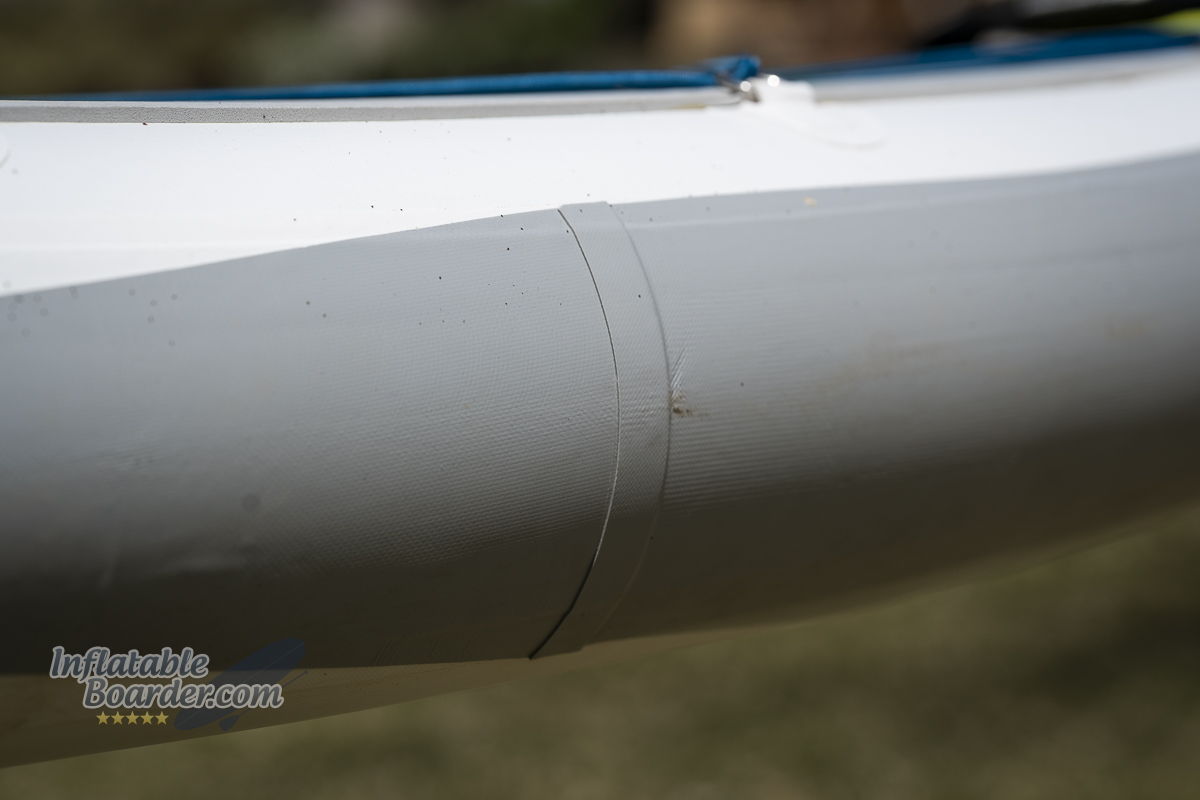
The AeroUltra construction is fairly simple with a single layer of PVC for the shell and dual layer PVC rails.
Inside the LowRider 11’6 is a standard knitted drop stitch core to give the board its 6” thickness and keep it flat while inflated. These cores use a layer of knitted polyester fabric for the top and bottom of the board and connect them with thousands of yarns sewn between the two layers. This type of drop stitch core has been used widely for a long time and balances affordability and performance, though it’s not quite as rigid or light as newer woven core builds.
The deck and hull of the LowRider 11’6 use a single layer of reinforced PVC material mechanically bonded to the drop stitch core to make the board air tight and rigid. These layers are then joined together around the edge of the board with a heat-pressed inner rail band made of PVC to complete the air tight chamber. A second, larger, layer of reinforced PVC is then glued around the edge to protect the inner layer and provide more rigidity.
Once the main structure of the board is built, the LowRider 11’6 gets a full-length deck pad and all of its on-board features installed. All of this adds up to a surprisingly light weight of just 24.6 pounds. With an overall size of 11’6 long and 36” wide, this is an extremely light paddle board.
One downside with such lightweight constructions is in board rigidity. The single-layer shell and 15 PSI maximum inflation recommendation make the LowRider 11’6 noticeably less rigid than heavier builds like the dual-layer AeroBote HD Aero or the additionally reinforced Blackfin Model XL.
In our static weight bend test, the LowRider 11’6 bent just over 2.9” with 170 pounds of weight in the standing area. This is a lower result than the similarly-built LowRider 10’6, and significantly below our current running average result of 1.6”.
Our bend test helps us directly compare different types of constructions, but when you are on the water, the boards have support under their entire length and often feel more rigid than their bend test may indicate.
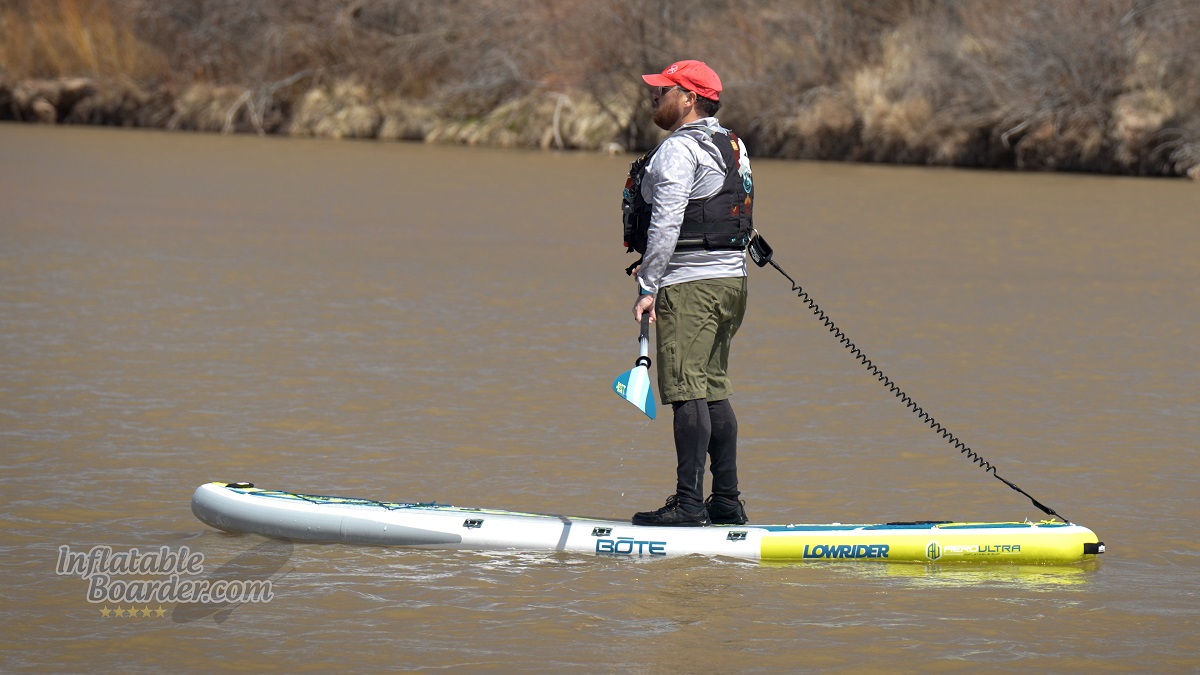
There is some noticeable flex in the LowRider 11’6 simply while standing and paddling.
While out on the water the LowRider 11’6 did feel more rigid than I would have expected based solely on its bend test result, however there was still some noticeable flex. I could feel the board flex under my feet when standing on the board and paddling normally, but normal cruising pace paddling didn’t make the board bounce around. However paddling quickly in our sprint testing did also generate a large amount of flex.
When walking or repositioning on the board I could feel it flex and rebound very easily, and bouncing on the board generated significant flex, but it did feel calm and comfortable as it settled back flat once I stopped. The same was true as I lifted the front half of the board out of the water for a pivot turn – I could easily feel the board flex and rebound, but it wasn’t springy nor did I feel like I was going to be thrown off.
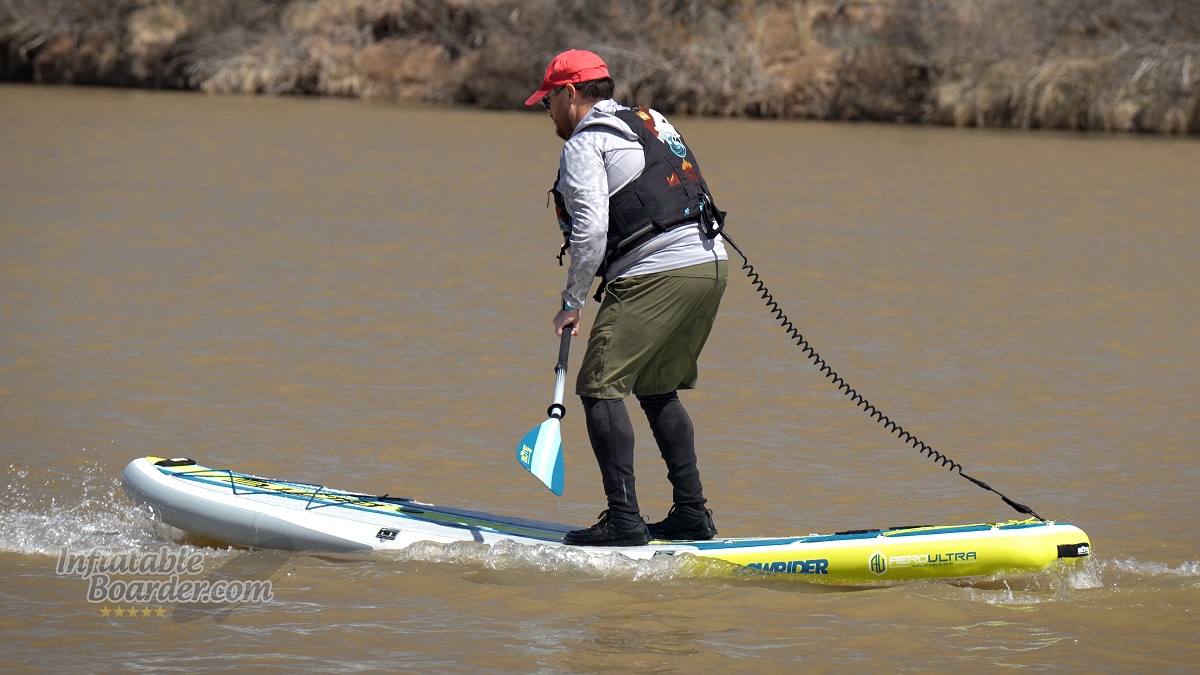
Walking and bouncing on the board generates significant flex.
Overall, the LowRider 11’6 is built well for its intended purpose of being a lightweight fishing/cruising/kayaking/tandem paddle board. Individual users under 200 pounds are not likely to notice the board flex during normal paddling, and by distributing passenger and cargo weight evenly, much of this flex will simply balance out.
Specifications
| Dimensions | |
| Length | 11’ 6” |
| Width | 36“ |
| Thickness | 5“ |
| Weight | |
| Max Capacity | 500 pounds |
| Board Weight | 24.6 pounds |
| Kit Weight (SUP & accessories) | 59 pounds |
| Buying Info | |
| List Price | $899 |
| Warranty | 2 years |
| Returns period | 30 days |
Bote LowRider 11’6 Tandem iSUP+Kayak Review – Features, Accessories and Versatility
The Bote LowRider 11’6 is made to be extremely versatile. You can paddle it solo or tandem; fish, cruise, do yoga; and it’s set up for a quick change between paddle boarding and kayaking whenever you like with the included accessory kit.
In addition to the various mounting points and cargo areas, the LowRider 11’6 Tandem also has Bote’s Full Trax full-length deck pad for comfort and traction no matter where you, or your paddling partner, are standing or sitting.
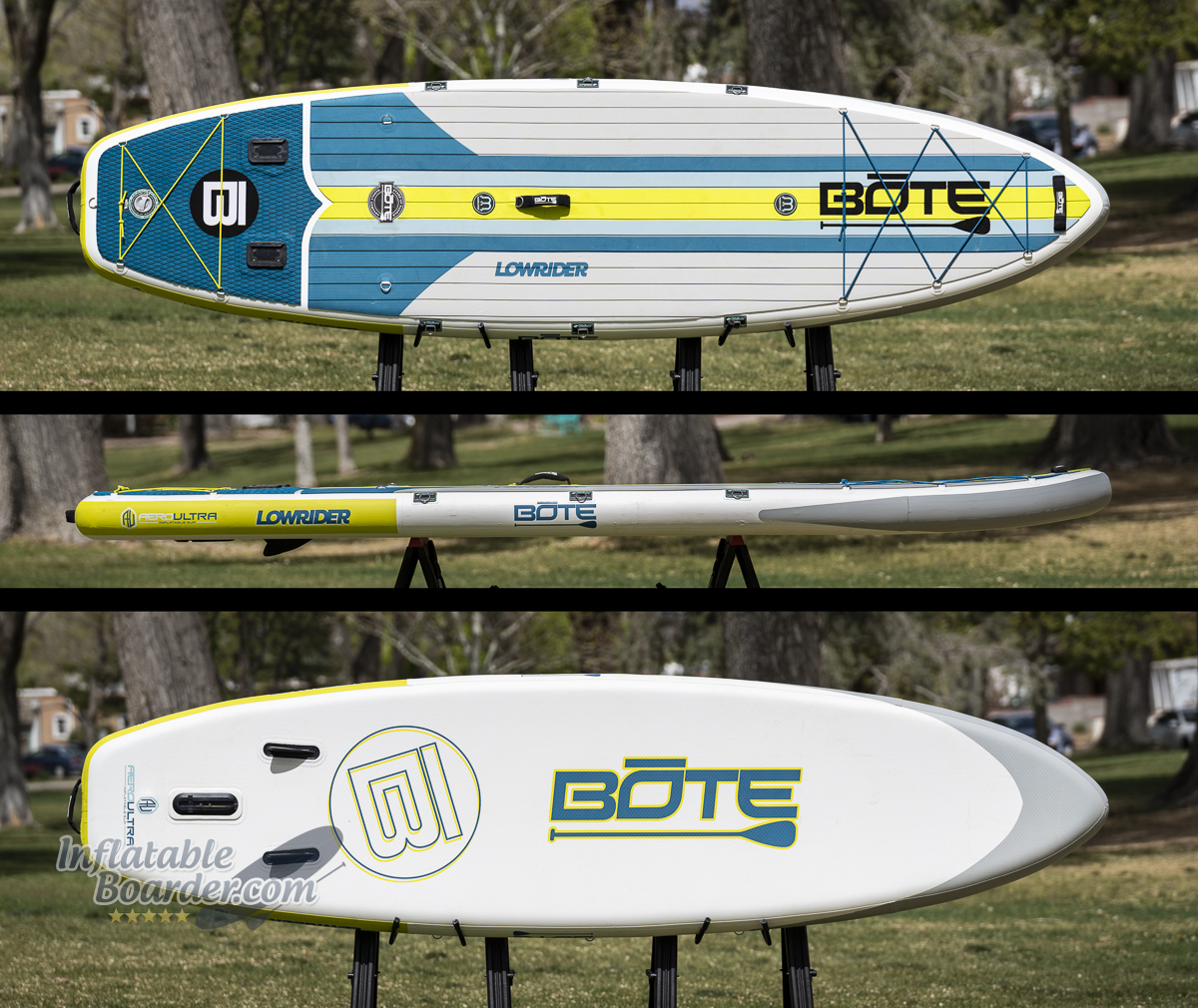
The Bote LowRider 11’6 Tandem is 11’6” long, 36” wide, and 6” thick. It has a maximum weight capacity of 500 pounds and weighs just under 25 pounds for just the board.
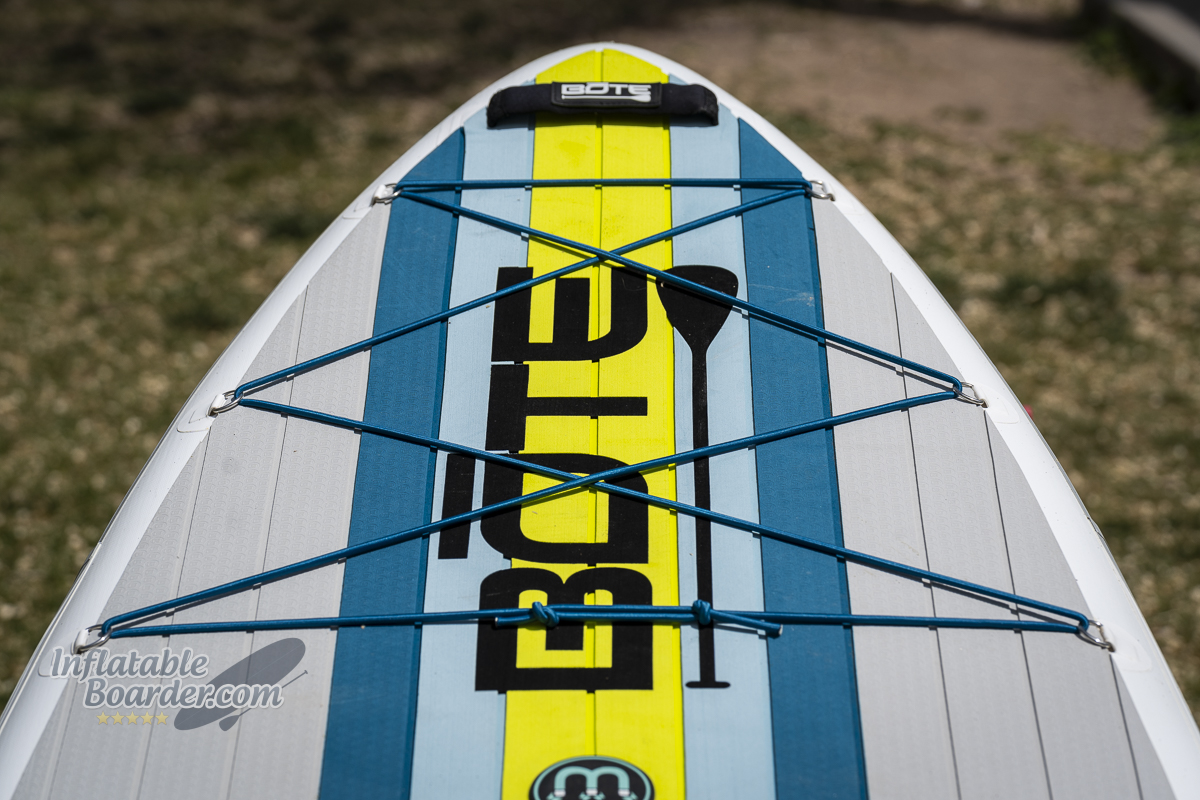
The nose is kept fairly wide, but does taper to a medium point through the front few feet. It has a large cargo area on the front of the board with an adjustable bungee cord strung between 6 D-rings.
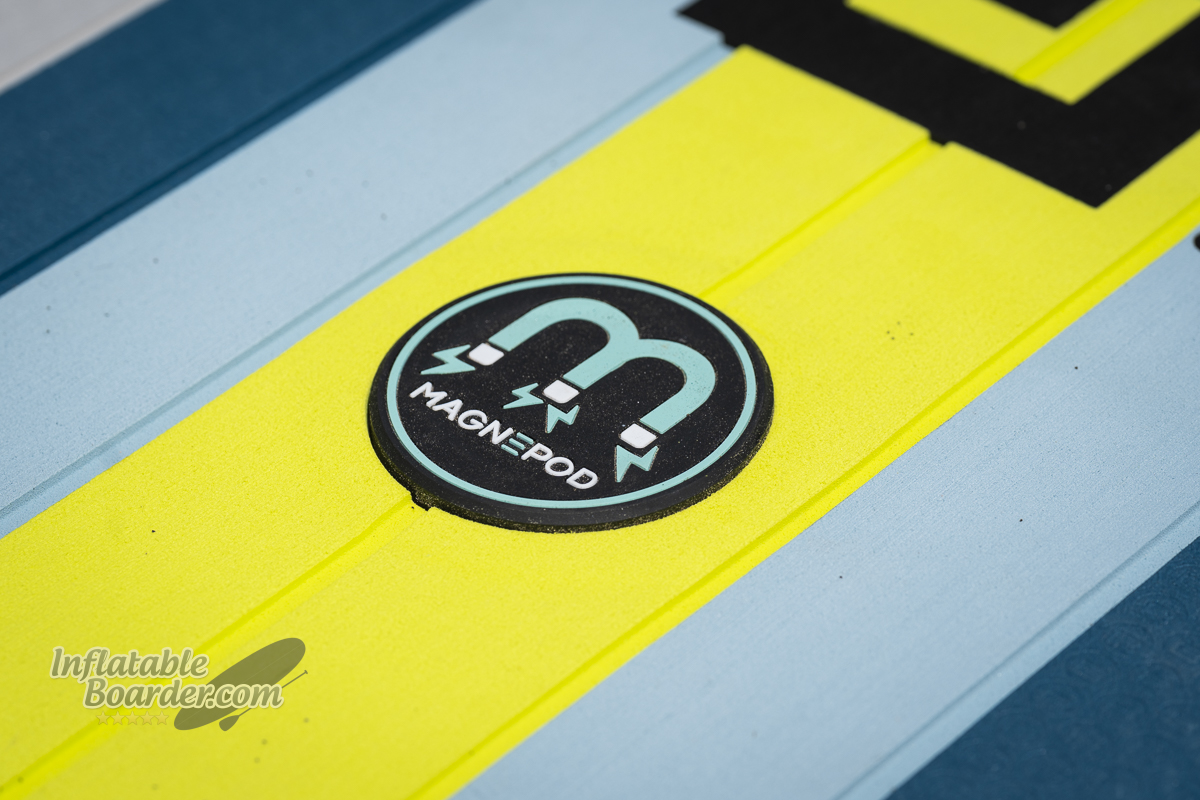
There are two Magnepod accessory mounts on the LowRider 11’6. These strong magnetic mounts are compatible with several accessories from Bote including drink tumblers and speakers.
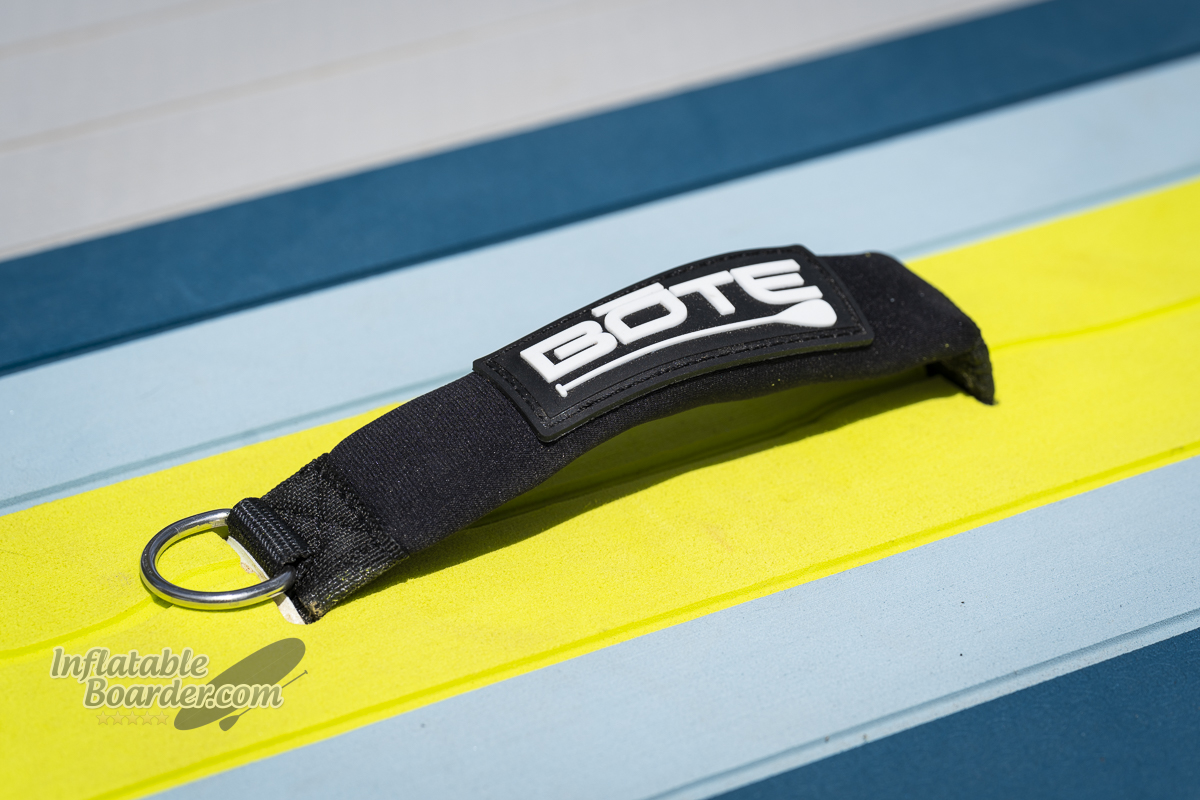
There are three padded carrying handles on the LowRider 11’6 and the center handle has a secondary leash attachment D-ring built into the handle..
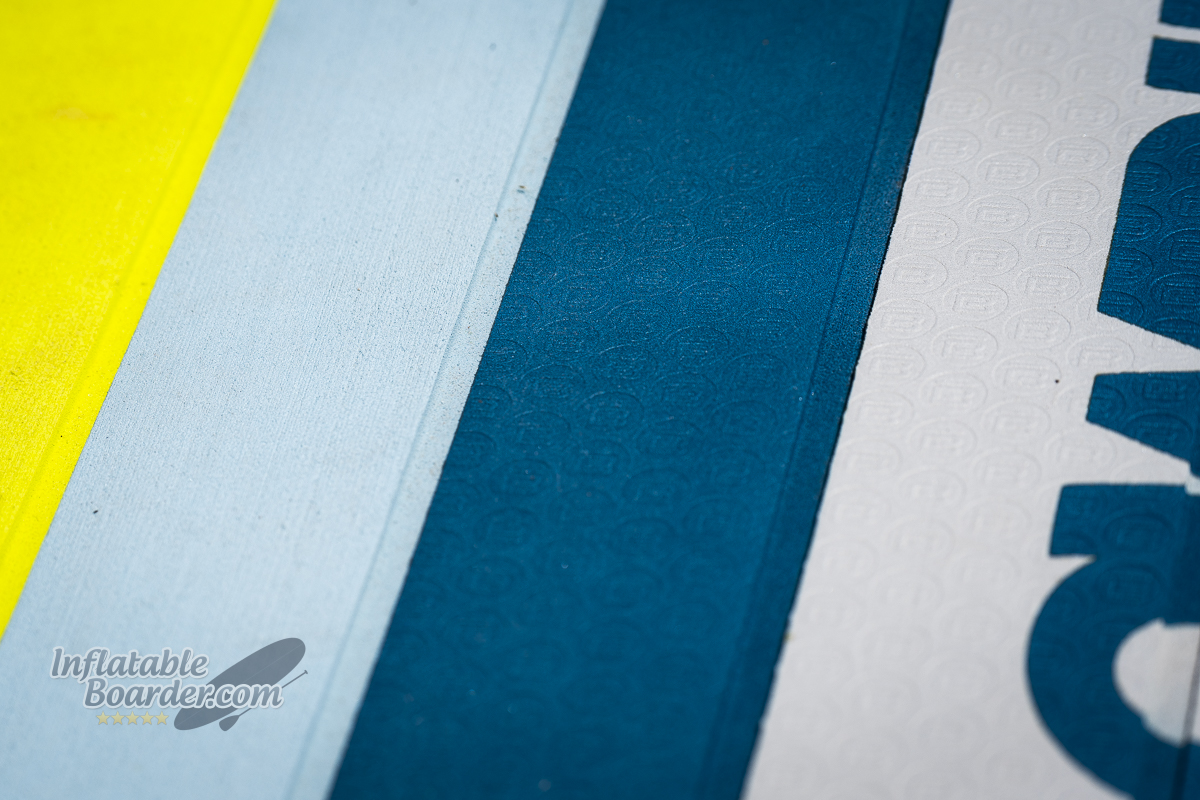
The Full Trax full-length deck pad is made with soft-texture EVA foam panels down the center and logo-embossed EVA foam panels on the edges for improved traction.
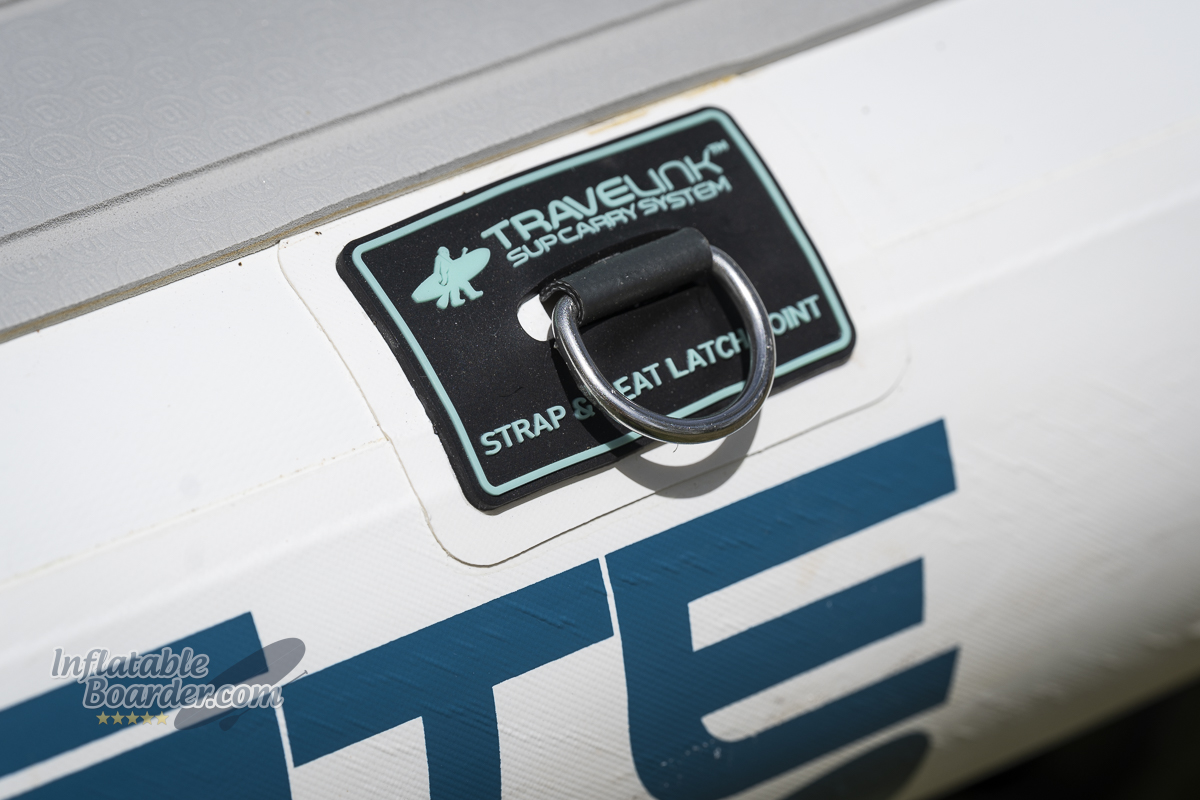
There are three D-rings on each side of the LowRider to use wit the Bote TraveLink shoulder strap and with the included inflatable kayak seats.
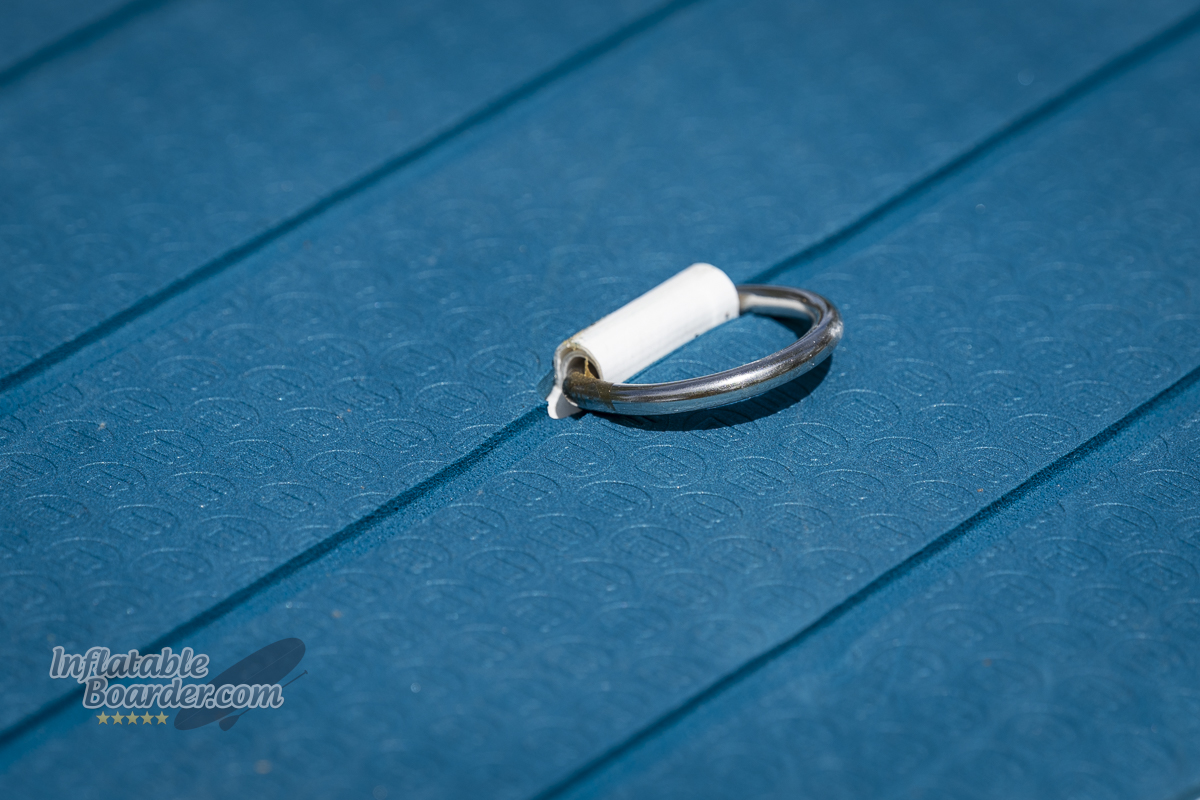
Behind the main standing area are two small D-rings for lashing down coolers.
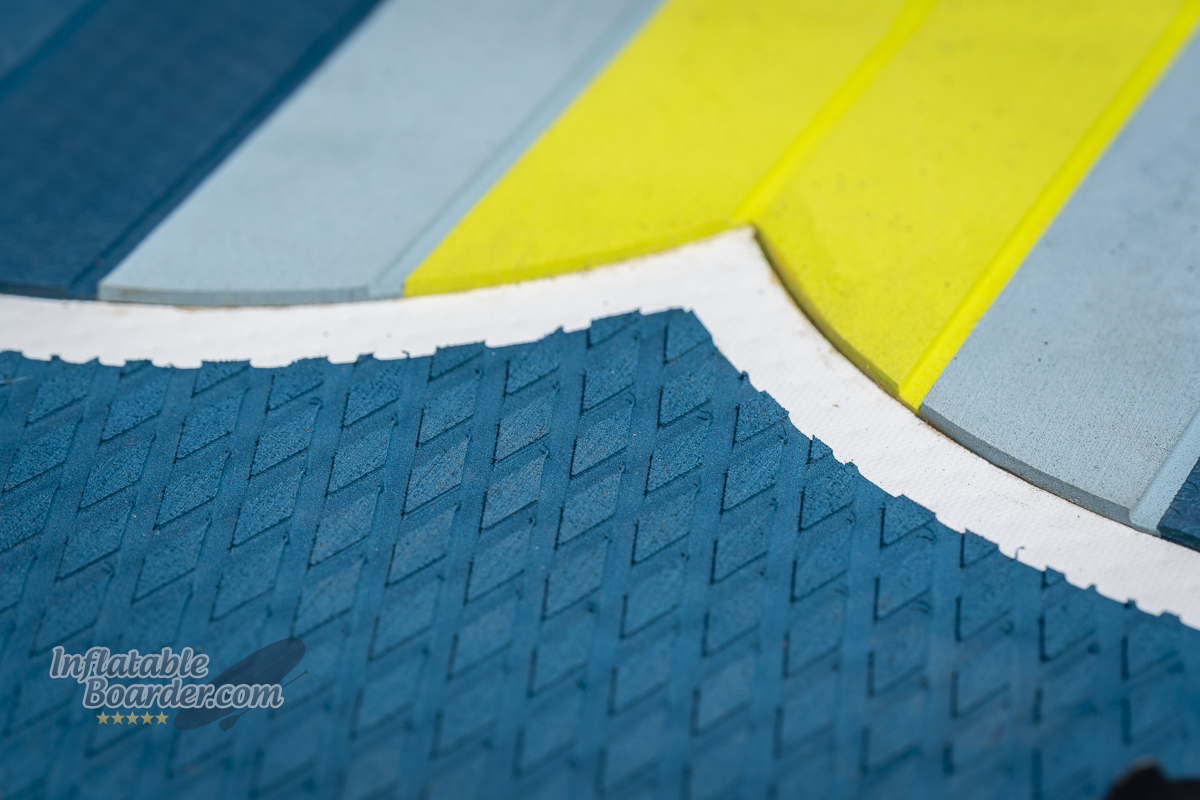
Toward the rear of the board, the deck pad switches from a brushed/embossed texture to a deep diamond groove pattern for improved traction while standing on the tail of the board.
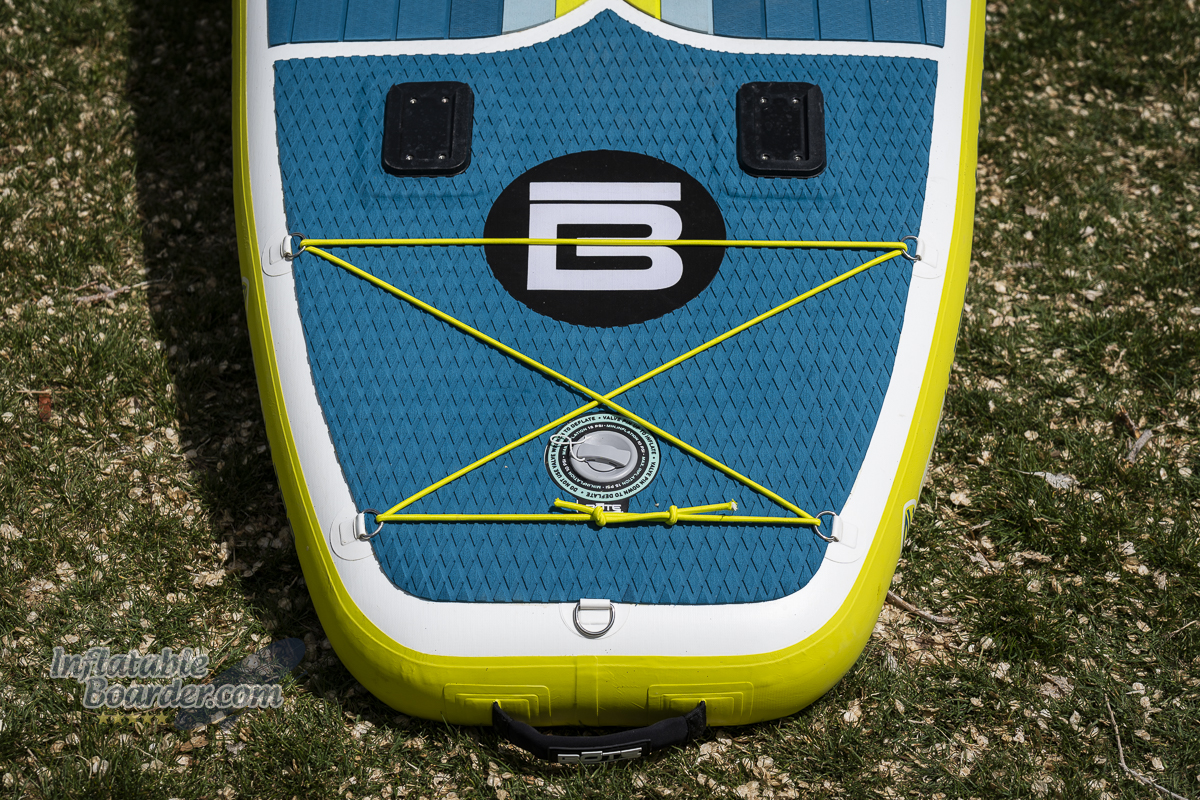
AT the rear of the board the LowRider 11’6 has slide-in receivers for the included AeroRack mounting feet, a four-point cargo bungee, leash D-ring and inflation valve.
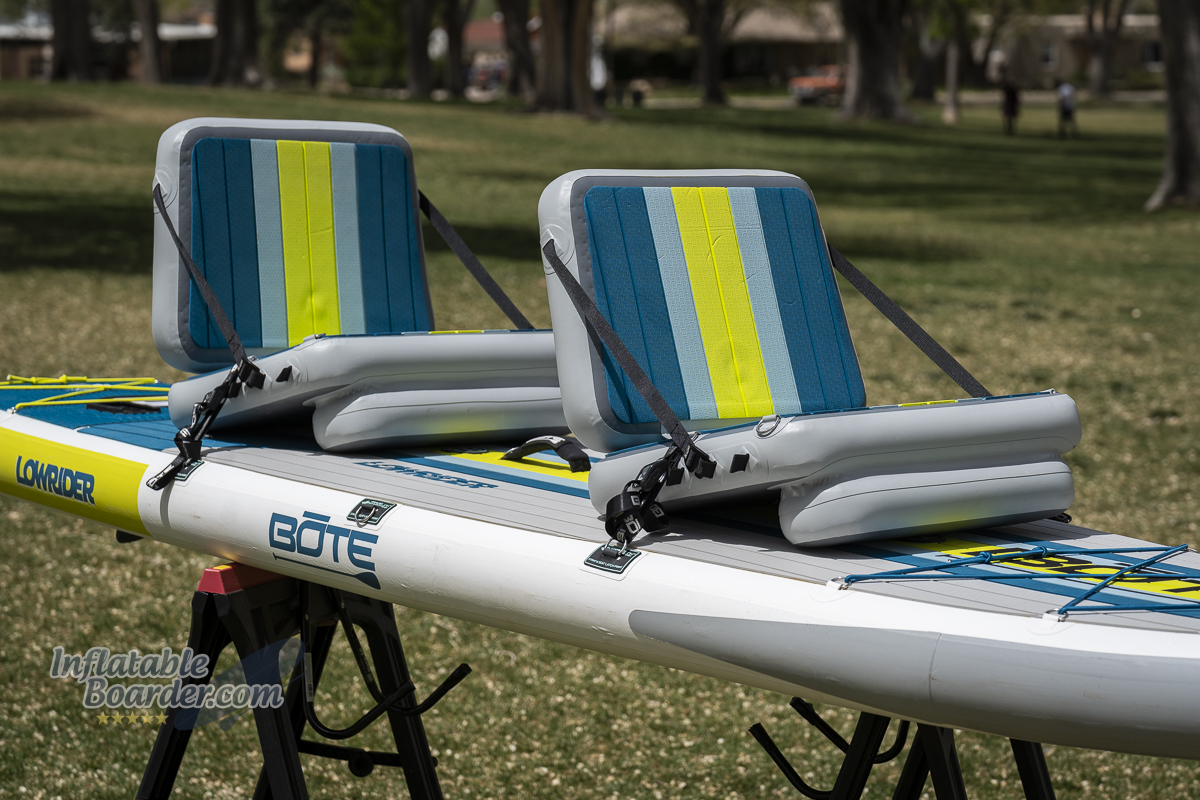
The LowRider 11’6 is designed for tandem use and comes with two inflatable kayak seats as well as two paddles.
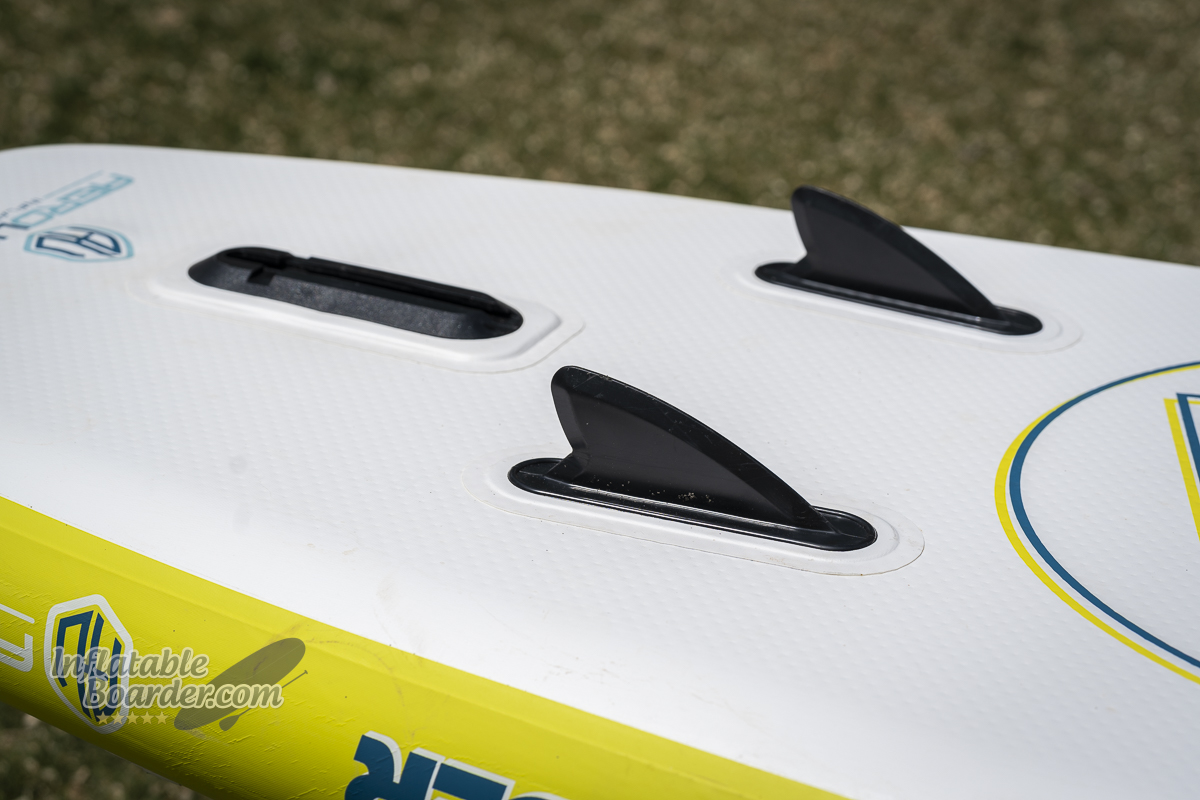
Under the board, the LowRider 11’6 has two fixed side bite fins and a center slide-in fin box.
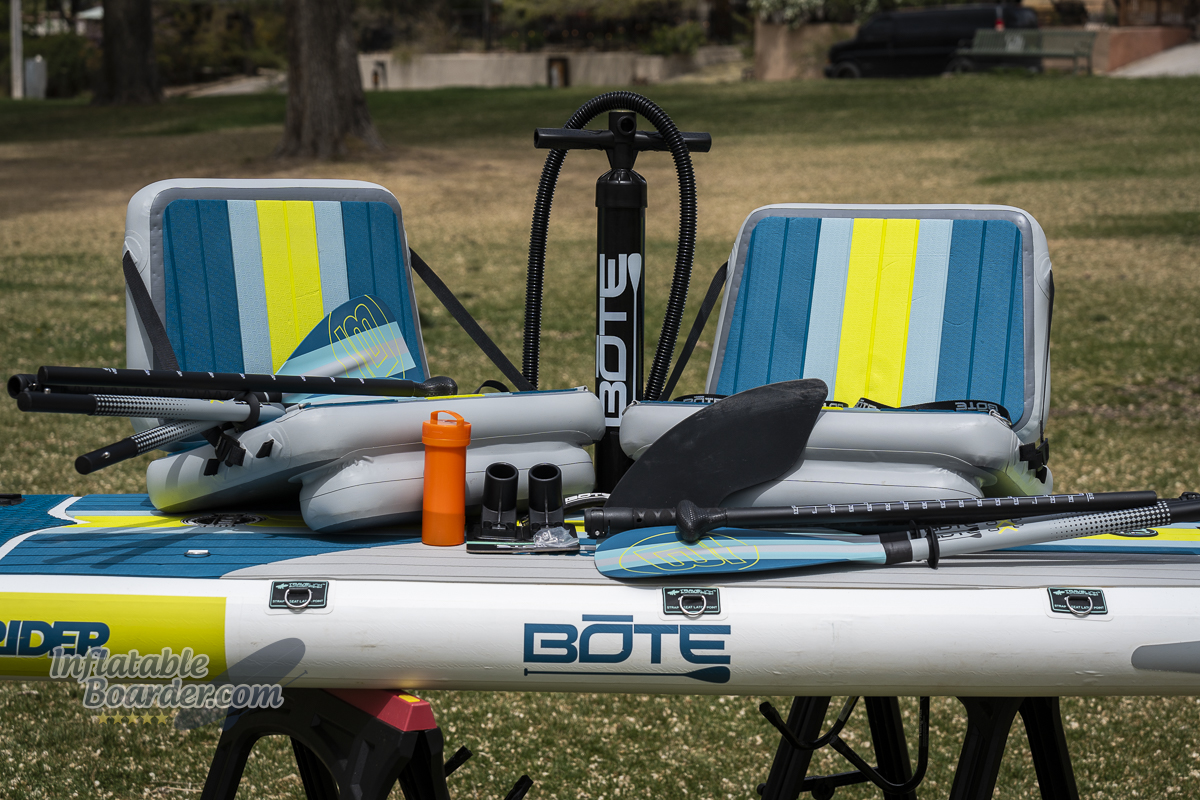
The LowRider 11’6 comes with almost everything you need to be on the water – just add a leash and PFD and you’re ready to paddle.
The LowRider 11’6 comes as a nearly complete kit with everything you need to get on the water except for a leash and PFD. Both items are important safety equipment for all paddlers and may also be required by law depending on your location.
Included with the LowRider 11’6 Tandem board you also get:
- A single chamber hand pump
- Repair kit
- AeroRack Receiver Feet
- 10” large surface area center fin
- Two inflatable kayak seats with cam straps
- Two hybrid SUP/Kayak paddles
And all of this easily fits into the new rolling backpack that comes with the kit. The water resistant backpack has two padded handles and a backpack harness along with two wheels for easier transportation. The bag itself is larger than a typical iSUP bag to easily accommodate the inflatable kayak seats and extra paddle along with your other daily necessities. There are compression straps around the bag, however the fixed ends are the same length as the bag is deep, so they don’t provide any true compression. If you do have to carry the kit as a backpack you will feel items slide around inside because of this.

The new LowRider bag (right) is noticeably wider than a standard iSUP bag (left).
There is also a large zippered pocket on the front of the bag to hold and organize the smaller accessories and personal items.
In all the complete kit weighs in at a scale-tipping 59 pounds.
Bote LowRider 11’6 Tandem iSUP+Kayak Review – Paddle
The LowRider 11’6 Tandem comes with two fiberglass/ABS plastic hybrid paddles that easily convert from SUP paddles to kayak paddles.

The new fiberglass Axe paddle has a slightly smaller ABS blade and symmetrical shaft.
This new version of the Bote Axe paddle can be used as both a SUP paddle and as a double-bladed paddle for kayaking. The shaft and SUP handle section are both made of fiberglass. This makes the paddle noticeably lighter than the aluminum version of this paddle that comes with the EasyRider 10’4, and provides a moderate amount of flex for all-day comfort. Fiberglass is also more impact resistant as it will flex and return back to its original shape rather than have a permanent bend like aluminum.
The handle section of the paddle has a textured plastic palm grip and length indicators to help you set the paddle to your preferred size. However there is no indexing mechanism, so you do want to check that your handle is properly aligned with the blade each time you adjust the length.
The blade section attaches to the paddle shaft with both a push-button release mechanism and a compression collar, and the shaft is built symmetrically so it does not matter which end you use for the blade and the handle.
The ABS plastic paddle blade is built for durability, so it is a bit heavier than fiber-reinforced nylon blades or composite paddle blades of the same size. The fiberglass paddle shaft helps balance the extra weight of the blade and the paddle doesn’t feel as blade heavy as the previous version of this paddle.
The main section of the paddle is covered with a rubberized grip sleeve. Whether or not to add rubberized grip material to a paddle is a very personal choice. I’m not personally a fan of it as I don’t find that I need any additional grip, and I did find this cover to rub my skin a little bit. On the other hand I know several people that add rubberized grips to every paddle they have because they do like the extra traction.
The blade itself is medium-sized with a narrower teardrop shape compared to the previous version. I think this is a huge improvement, especially for paddlers under 160 pounds who don’t need such a large paddle blade. The blade does have some curve to it to help hold in the water, but the smooth face and light curve still let the paddle wander and flutter more than paddle blades with more active blade shapes.
Overall the fiberglass/ABS Axe paddle fits the performance profile of the LowRider 11’6 well and makes for a quick and effective switch from SUP to kayak paddling.
Bote LowRider 11’6 Tandem iSUP+Kayak Review – Stability
At 11’6” long and 36” wide it’s no surprise that the Bote LowRider 11’6 is a very stable paddle board.
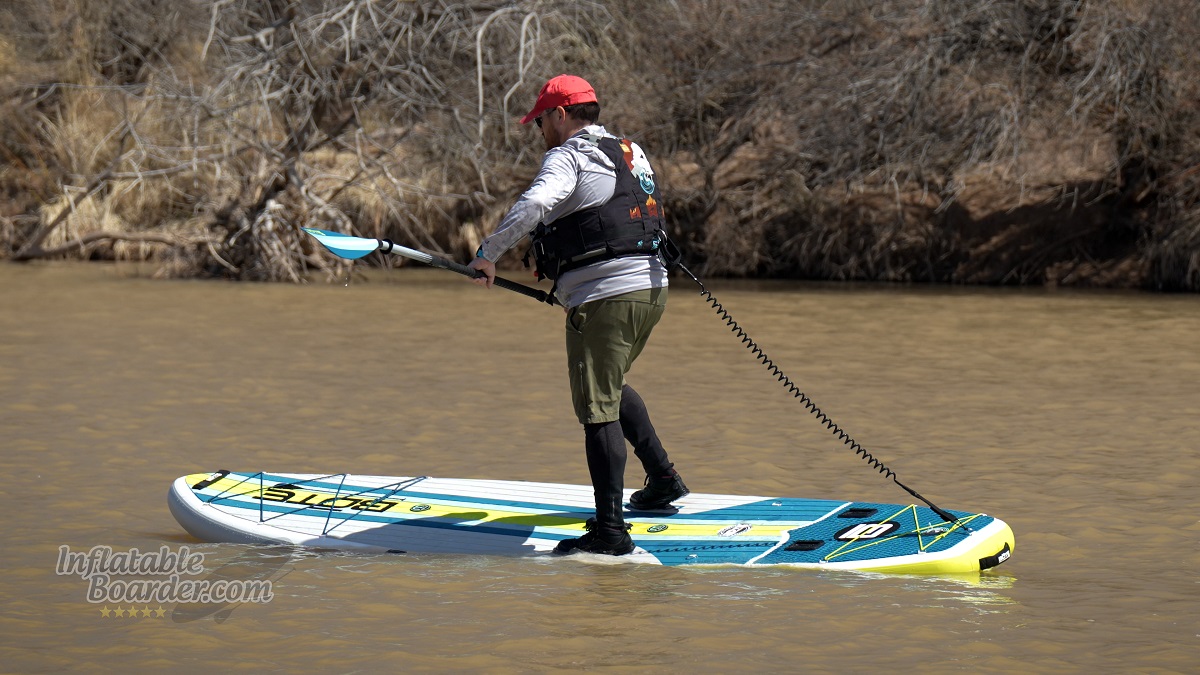
The large size and gentle tapered shape keeps the board steady even when held on its edge.
When first stepping onto the LowRider 11’6 I immediately noticed just how large this board is. The 36” width just feels big on the water, but that also helps make it incredibly stable. I didn’t feel any rolling or twitching at all, even when paddling in gusty wind conditions and choppy water.
The LowRider 11’6 has a wide square tail and a fairly broad nose. This helps keep the board wider and more consistent feeling through the middle section of the board. Standing basically anywhere from just behind the front cargo area to just in front of the tail section of the deck pad has a very similar feel. The lightweight board does have a few minor drawbacks in stability, though. First is what I’ve been calling a “lightweight board feel” where the lower mass of the board is just easier to tilt when shifting your weight compared to slightly heavier boards of the same size. It’s a fairly small thing, and probably only truly noticed when directly comparing paddle boards, but it is there.
The second is the board’s flexibility. I can feel the LowRider flexing a little bit under my feet and while paddling. Less rigid boards like this mean your feet have to work a little harder and your legs have to absorb more changes in position as you paddle compared to a more rigid board. This does reduce the stability feeling a little bit and can tire your feet and legs more quickly. But the sheer size of the LowRider 11’6 more than makes up for these setbacks during normal paddling.
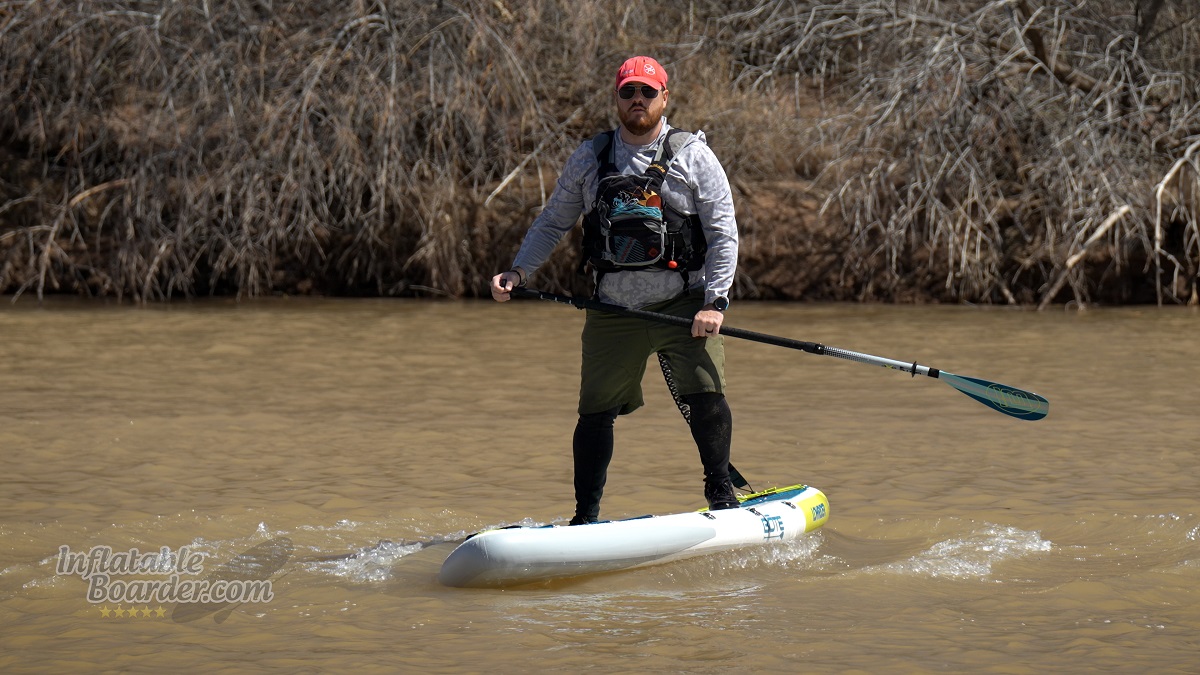
Rocking the board is smooth, and the rails dip and resurface predictably.
I was able to easily hold the LowRider 11’6 on its edge and rock the board side to side without feeling like it was twitching or rocking erratically. The largest impact in stability I felt was while walking on the board and when I had more than a third of the board out of the water at once for a pivot turn. I noticed quite a bit of flex and rebound in the board while walking on it and pivot turning, though the large tail size still made pivot turns feel secure, even if the board did flex while out of the water.
Overall the LowRider 11’6 does have very good stability. It’s definitely stable enough for tandem paddling, fishing, and SUP yoga, and is a great option if you tend to be more of an angler that likes to bring everything including the kitchen sink.
Bote LowRider 11’6 Tandem iSUP+Kayak Review – Speed
The LowRider 11’6 Tandem SUP has good speed performance given its large size.
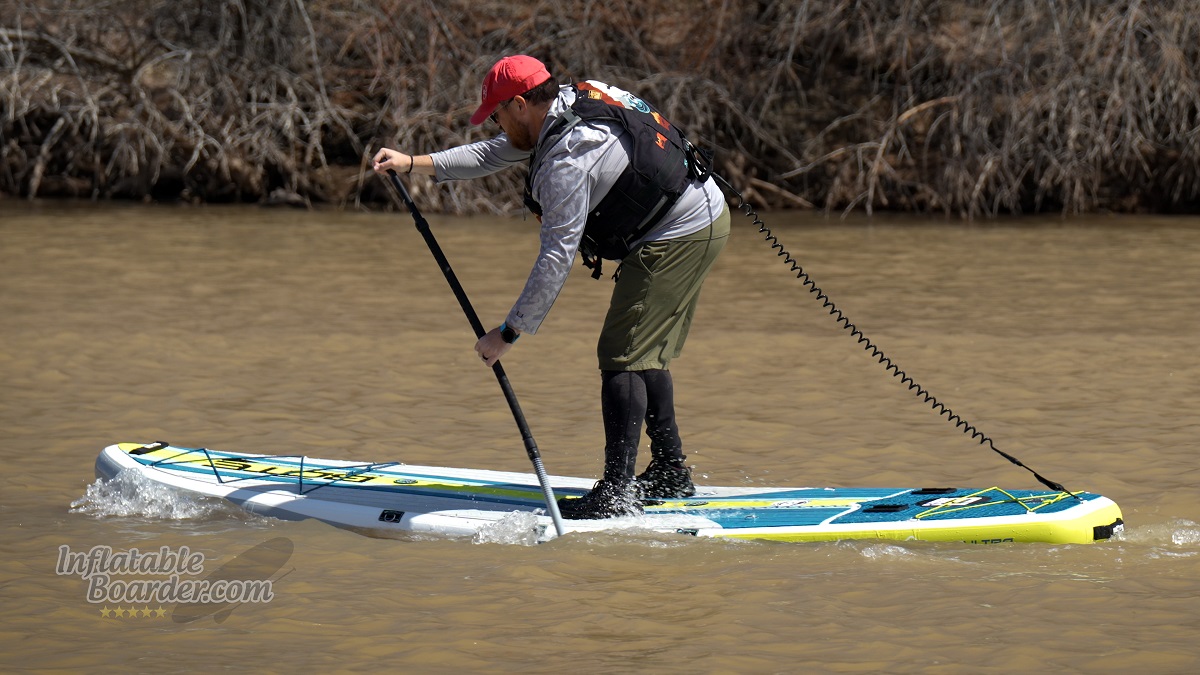
The LowRider 11’6 has a moderate sprinting speed, but paddles better at a more casual pace.
While paddling hard for our sprinting speed tests I noticed right away that the LowRider 11’6 was flexing causing it to push through the water, and had a bit of difficulty staying on course. But even with all of that going on, it did well for such a wide paddle board.
In a sustained sprint I was able to paddle an average of around 5.2 MPH, and I reached a maximum speed of 5.5 MPH. Racing SUP this is not, but it did actually outperform my expectations.
Likewise, the Bote LowRider 11’6 also had good cruising speed performance, and even outperformed a few slightly narrower (34-35”) and more rigid iSUPs. At a casual pace of around 25 strokes per minute, the LowRider clocked in at 3.5 MPH. While that’s roughly the speed of a brisk walk and fairly average for most all-around iSUPs, none of those boards are this wide! As I’ve mentioned earlier, I could feel some flex in the board even at cruising speeds and that does give it more of a pushy feel, but the LowRider also had a good result in our efficiency testing.
From a cruising speed, the LowRider 11’6 travels around 20’ per stroke before slowing down, or about 1.7 board lengths. That’s definitely on the higher side of efficiency for larger, cruiser-style, paddle boards we’ve tested.
If we only look at the speed scores, the LowRider 11’6 does come out just a little below average across our testing, but once you factor in its large size and high capacity, the LowRider 11’6 is actually kind of quick.
Bote LowRider 11’6 Tandem iSUP+Kayak Review – Maneuverability and Tracking
We found the Bote LowRider 11’6 Tandem greatly favors tracking performance over maneuverability, but can still turn and steer with relative ease.
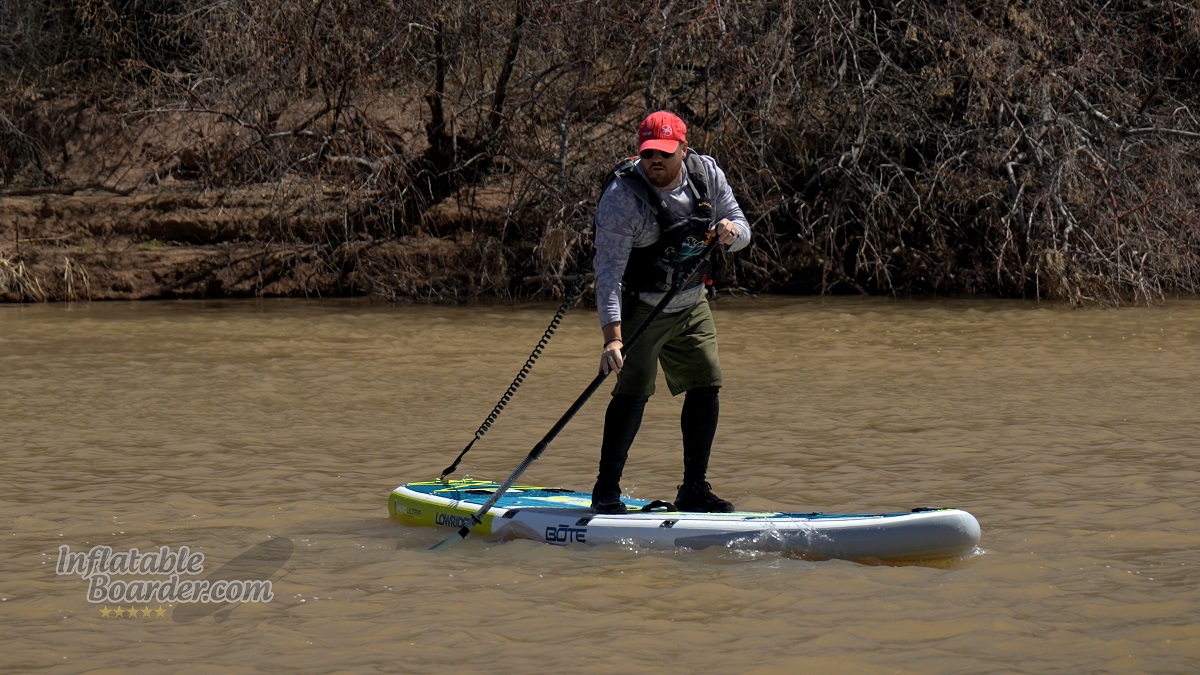
Turning the LowRider 11’6 in large increments is best done with reverse or combination strokes for a quicker turn.
In our maneuverability testing we focus on how well a paddle board turns when using very basic and less-efficient strokes to really gauge its performance. Any paddle board can turn quickly with advanced techniques, but that doesn’t help identify a board’s potential strengths or weaknesses.
To test maneuverability, we use forward sweep strokes (paddling in an arc from nose to tail) to turn a complete circle from a standstill. The Bote LowRider 11’6 needed an average of 9.25 strokes to make the full circle turn. That is a pretty large turning radius and is something we normally see in longer paddle boards (though a few shorter ones have proven as difficult to turn as well).
But with the same stroke done in reverse (from tail to nose) you turn the board against its fins rather than with them, and the LowRider 11’6 quickly turns the same full circle in just 4 strokes on average.
And while making such a large turn can be tricky, it’s also not an incredibly common maneuver. I found the LowRider 11’6 to easily steer and turn up to about 90° with just two or three strokes.
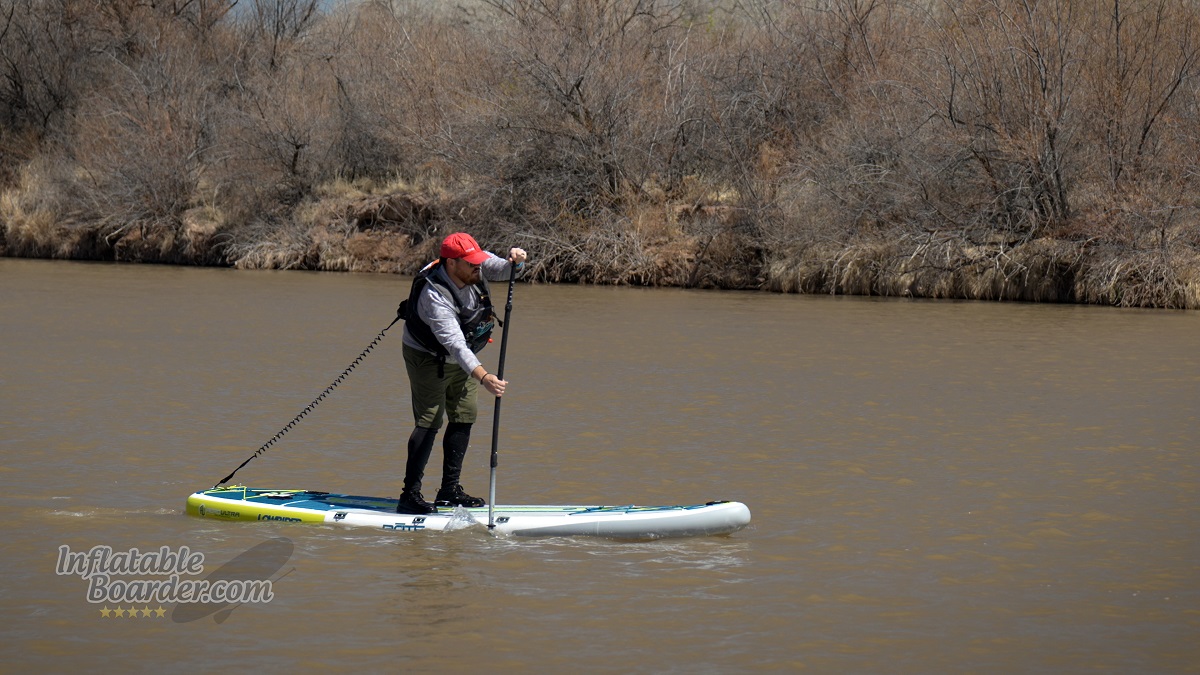
The LowRider 11’6 has significantly better tracking performance than I anticipated.
Even though it can be a little tricky to turn the LowRider 11’6 in large increments, on the flip side it is very easy to keep tracking in a straight line.
Like how a 360° is not a common thing to do, most paddle boarders tend to switch which side of the board they are paddling on every 5-6 strokes while casually cruising. So in our tracking stress test we find out how well a board can stay on track when taking 10 strokes on a single side of the board.
The LowRider 11’6 greatly outperformed my expectation in this test. After 10 paddle strokes, I was only pointed off course by an average of 12°! Most dedicated touring iSUPs are between 5-10° and most all-around and cruising boards between 15-25°.
The wider a paddle board is, the more difficult it is to paddle in a straight line. You have to reach much farther to the side to get your paddle straight up and down when on a 36” board than you do a 32” wide SUP. During the tracking test I am focusing on maintaining the best technique I can. But while just cruising around on the LowRider 11’6 I did feel that it’s tracking performance was not as good as in our test. Most likely this is due to using less-strict paddling technique with the paddle not completely vertical during the stroke. When the paddle is angled to the side it puts more turning force on the board. So as I relaxed my technique, so to did the LowRider 11’6’s tracking performance relax.
However, the LowRider 11’6 does respond well to basic steering input, so while it’s casual paddling tracking performance may not be quite as good, it’s still easy to keep the board moving toward your destination.
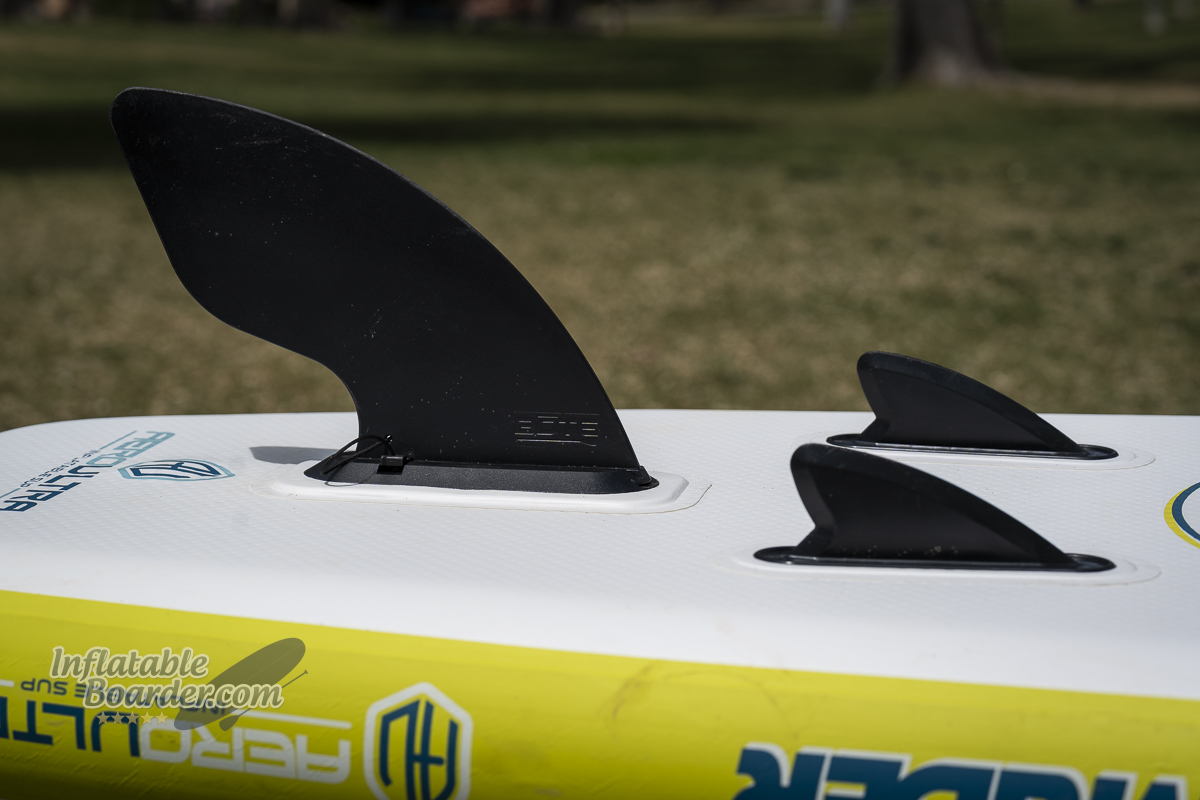
The LowRider 11’6 has two fixed side bite fins and a large center slide-in fin.
The LowRider 11’6 has a single slide-in fin box and two fixed side-bite fins under the board. The side fins are primarily aesthetic and don’t really aid much in tracking performance. The biggest impact they have is in slowing the board down, especially since they are toed-in (angled) toward the center of the board. These fins really aren’t necessary, and if you paddle in shallow water or want more maneuverability, it’s best to replace the center fin with a shallow water option.
Bote includes a 10” long, extra-large-surface-area fin with the LowRider 11’6. This large fin does all the heavy lifting when it comes to keeping the board moving straight. Bote also offers a 3” and 5” fin option for shallow water paddlers.
The fin box itself is not my favorite. Slide-in fin boxes have, in my experience, more issues with finding fins if you need a replacement, fin options, fit between the fin and fin box, and overall durability compared to US and fliplock style fin boxes. I’ve personally had more issues with getting fins to fit in these fin boxes (often resorting to using hammers or having to kick them in a pinch), and I’ve also seen this style of fin box simply break or bend completely out of shape if the board is not rolled completely. I have had trouble getting the fin to fit into the fin box of the LowRider 11’6 (and to come back out again). Bote has been using this fin box for many years now on its inflatable boards, but uses a Universal Standard (US) fin box on their hard boards. I’d really like to see Bote switch to this more robust and readily available fin box system on their inflatable boards as well.
Bote LowRider 11’6 Tandem iSUP+Kayak Review – Kayak Performance
With the included inflatable kayak seats and extra paddle blades, the Bote LowRider 11’6 quickly transforms from a stand up paddle board into a capable sit-on-top kayak.
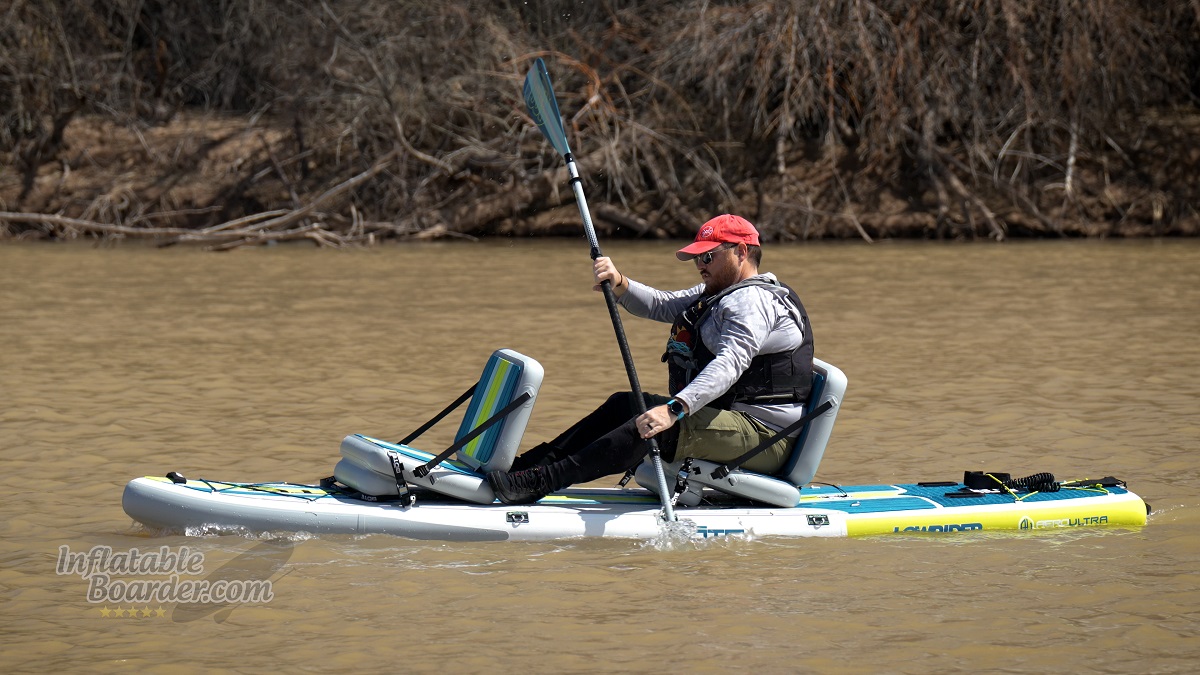
The inflatable kayak seats place your legs in a comfortable position for paddling.
The LowRider 11’6 Tandem is designed as a hybrid iSUP and sit-on-top kayak. To that, Bote has included two inflatable kayak seats and two extra paddle blades with the LowRider kit at no extra cost.
The Bote inflatable kayak seats are extremely comfortable. They quickly inflate to 7-10 PSI and provide great back support (in three different positions) and feature an “elevator” pad under the seat front to keep your legs and hips in a more comfortable position compared to flat kayak seats.
The seats attach to the board with two cam straps each. There are two positions on the seats and three positions on the board to attach the seats so you can dial in your location and fit on the board.
For most people there is enough room on the LowRider 11’6 to fit two adults, however if doubling up with passengers over 6’ tall, leg room may come into short supply for one or both paddlers.
With just two attachment points for the seat to the board I did find myself feeling a little disconnected from the board. It would be nice to have a third or fourth attachment point – particularly to anchor the back of the seat down. With just the two points I could feel the seat slide around a little bit when leaning from side to side in order to tilt the board for a quicker turn.
The hybrid paddle does a good job for kayaking. The narrower blades are more stable in the water compared to wider blades that flutter more with low angle strokes. While the paddle is a little on the heavy side, it wasn’t uncomfortable to use for long periods of time. I personally did not care for the rubberized coating on the paddle shaft as I find it to rub the skin of my hands more than the bare fiberglass paddle shaft, however I do know that many people appreciate the extra traction the coating puts on the paddle.
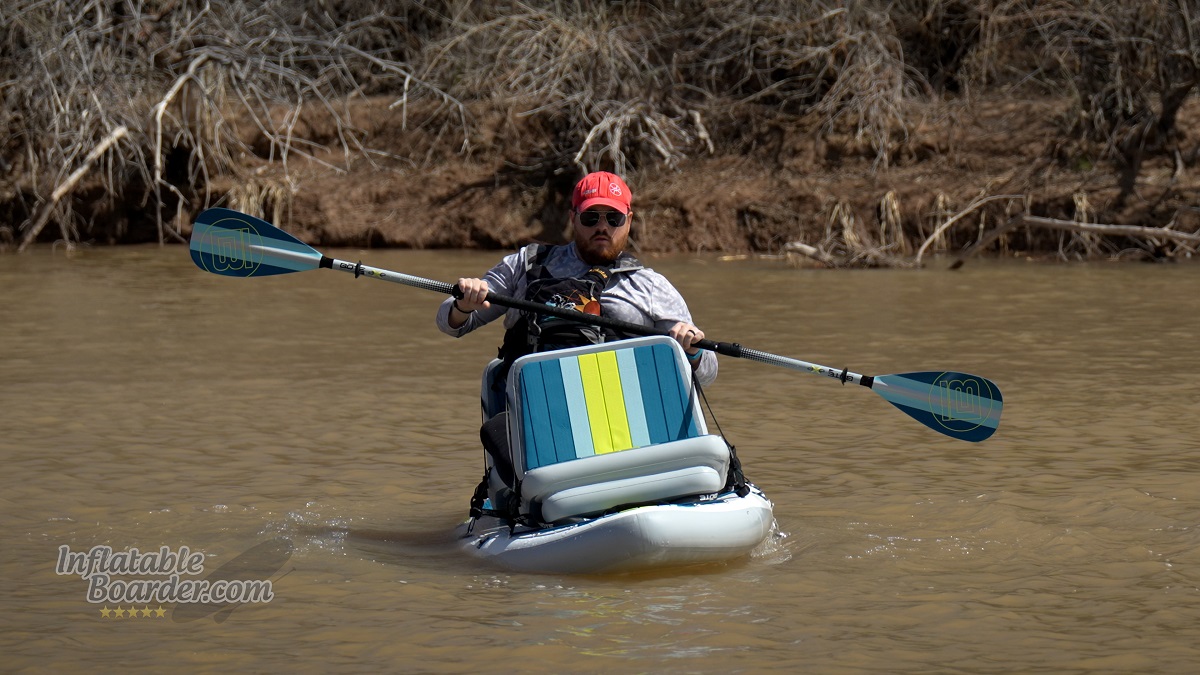
Tilting the LowRider 11’6 while seated was tricky due to the board’s width and seat stability.
On the water, the LowRider 11’6 performs very well as a larger sit-on-top kayak. It is still extremely stable – actually maybe too stable? I had a pretty hard time purposely tilting the board to lean into my downstream turns while paddling it on the river. But I also never had any close calls from leaning too far.
In addition to not being able to lean into my turns, I find I have less leverage for large turning strokes while seated, so big maneuvers were more difficult for me without using advanced stroke techniques.
Having a double-bladed paddle definitely moves the LowRider 11’6 faster in the water, and helps it track straighter since you can paddle evenly on each side without constantly changing hand positions.
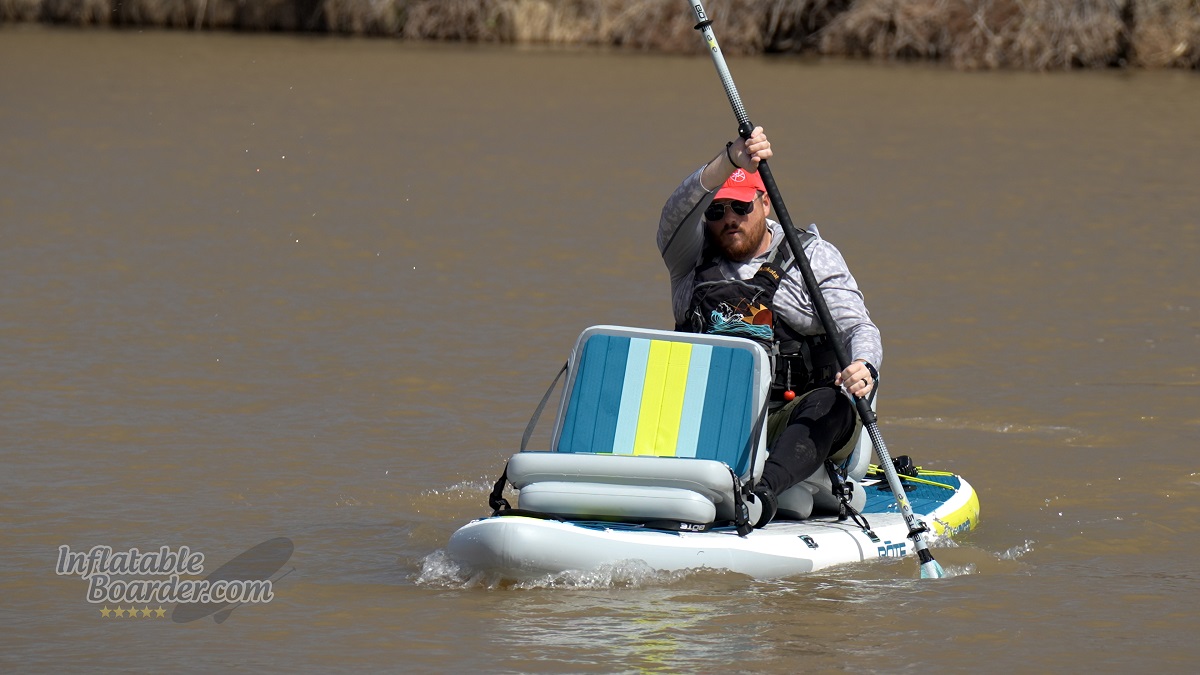
The LowRider 11’6 does move more quickly with two blades, but still has some pushy feeling when trying to go fast.
While taking more paddle strokes per minute is easier with the double bladed paddle, I did find that the LowRider 11’6 still had some flex and felt a bit pushy in the water, particularly when I did want to paddle quickly. I was able to set up the second kayak seat as a foot brace to use my whole body with each paddle stroke, however with a second paddler on board, this benefit is really only available for whomever is sitting in the back.
Overall the LowRider 11’6 makes converting to a kayak quick and simple. It has excellent tracking ability and stability, and is a great choice for the paddler who wants to be able to SUP one day, kayak the next, or do both in the same day!
Bote LowRider 11’6 Tandem iSUP+Kayak Review – Warranty and Customer Support
Bote includes a 2 year manufacturer’s warranty with the LowRider 11’6 Tandem, but only after it is registered with Bote. The bag, paddle, and other accessories are only warrantied for 90 days from the date of purchase. After purchase, users have a 30 day return period for like-new products returned with all accessories. Returns are subject to a 20% restocking fee and the cost of shipping. This is a fairly strict warranty and return policy, and the warranty period extends for what I consider to be the minimum brands should be covering their products. You can contact Bote’s customer service team via web form, website chat, email, or social media.
Bote LowRider 11’6 Tandem iSUP+Kayak Review – Final Thoughts
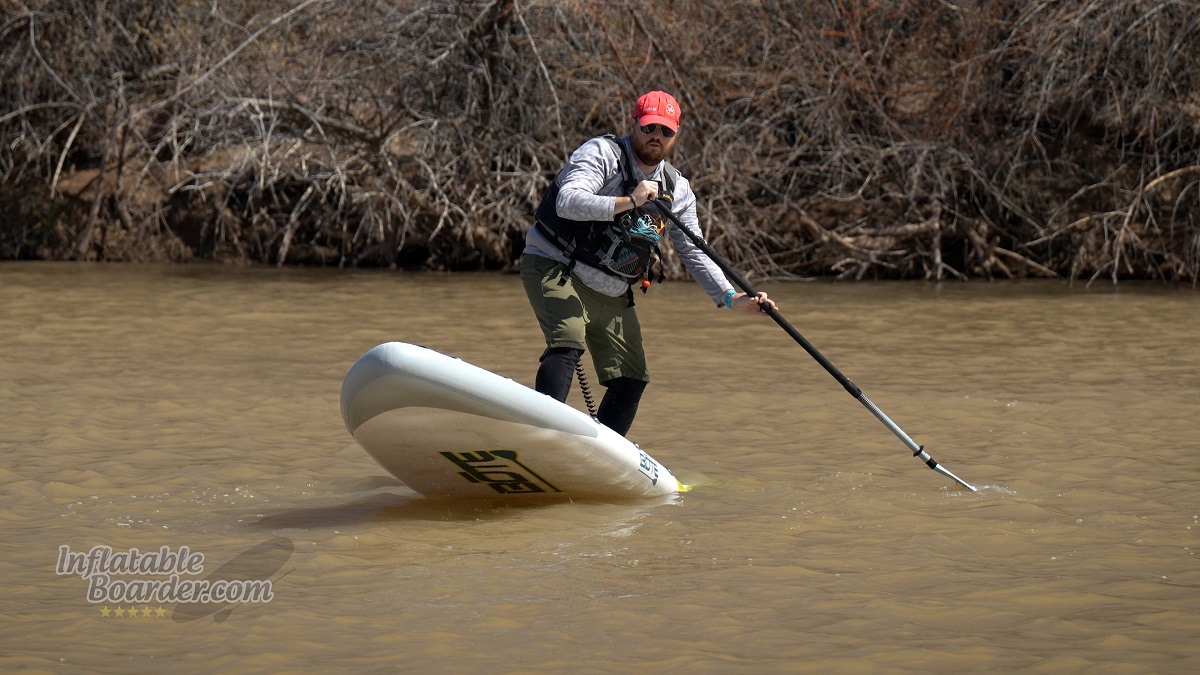
The LowRider 11’6 is a large, stable, hybrid iSUP and Kayak in one turnkey package.
Of Bote’s new “Rider” series paddle boards (the EasyRider 10’6, LowRider 10’6, and LowRider 11’6) I think I prefer the LowRider 11’6 the most. The extra tracking performance, capacity, and second seat and paddle make it great for longer days on the water or bringing a friend. Plus when you compare the value of the included kayaking accessories it’s an easy choice for me to pick the LowRider 11’6 over the LowRider 10’6.
Bote LowRider 11’6 Tandem iSUP+Kayak Review – FAQ
Does the Bote LowRider 11’6 Tandem come with a kayak conversion kit?
Yes, the Bote LowRider 11’6 Tandem comes with two inflatable kayak seats and two additional paddle blades to convert the SUP paddles into kayak paddles for you and your paddling partner.
Can I paddle the Bote LowRider 11’6 Tandem with a passenger or pet?
Absolutely! With the additional weight capacity, full length deck pad, and second paddle and kayak seat, the Bote LowRider 11’6 is purpose-built for paddling with a friend, family member, or pet.
How long does it take to inflate the Bote LowRider 11’6?
The Bote LowRider 11’6 is a large paddle board, and with the single chamber hand pump, expect to spend 12-15 minutes pumping the board depending on how vigorously you pump. I highly recommend an electric pump to completely automate this process, save you some energy, and allow you to finish getting ready to paddle while the board inflates.
Do I need to buy anything else before using the Bote LowRider 11’6 Tandem?
Yes. Unfortunately Bote does not include a leash with the Bote LowRider 11’6 Tandem. Leashes are key pieces of safety equipment for all paddle boarders along with a properly-fitted PFD/Life Jacket which you will also need.







Leave a Reply